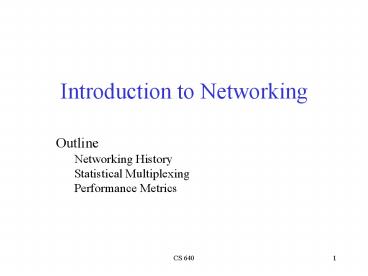Introduction to Networking - PowerPoint PPT Presentation
Title:
Introduction to Networking
Description:
Introduction to Networking Outline Networking History Statistical Multiplexing Performance Metrics A Brief History of Networking: early years Roots traced to public ... – PowerPoint PPT presentation
Number of Views:154
Avg rating:3.0/5.0
Title: Introduction to Networking
1
Introduction to Networking
- Outline
- Networking History
- Statistical Multiplexing
- Performance Metrics
2
A Brief History of Networking early years
- Roots traced to public telephone network of the
60s - How can computers be connected together?
- Three groups were working on packet switching as
an efficient alternative to circuit switching - L. Kleinrock had first published work in 61
- Showed packet switching was effective for bursty
traffic - P. Baran had been developing packet switching at
Rand Institute and plan was published in 67 - Basis for ARPAnet
- First contract to build network switches awarded
to BBN - First network had four nodes in 69
3
History of the Internet contd.
- By 72 network had grown to 15 nodes
- Network Control Protocol - first end-to-end
protocol (RFC001) - Email was first application R. Tomlinson, 72
- In 73 R. Metcalfe invented Ethernet
- In 74 V. Cerf and R. Kahn developed open
architecture for Internet - TCP and IP
4
History of the Internet contd.
- By 79 the Internet had grown to 200 nodes and by
the end of 89 it had grown to over 100K! - Much growth fueled by connecting universities
- L. Landweber from UW was an important part of
this! - Major developments
- TCP/IP as standard
- DNS
- In 89 V. Jacobson made MAJOR improvements to TCP
- In 91 T. Berners-Lee invented the Web
- In 93 M. Andreesen invented Mosaic
- The rest should be pretty familiar
5
Building Blocks
- Nodes PC, special-purpose hardware
- hosts
- switches
- Links coax cable, optical fiber
- point-to-point
- multiple access
6
Switched Networks
- A network can be defined recursively as...
- two or more nodes connected by a link, or
- two or more networks connected by two or more
nodes
7
Strategies
- Circuit switching carry bit streams
- original telephone network
- Packet switching store-and-forward messages
- Internet
8
Addressing and Routing
- Address byte-string that identifies a node
- usually unique
- Routing process of forwarding messages to the
destination node based on its address - Types of addresses
- unicast node-specific
- broadcast all nodes on the network
- multicast some subset of nodes on the network
9
Multiplexing
- Time-Division Multiplexing (TDM)
- Frequency-Division Multiplexing (FDM)
10
Statistical Multiplexing
- On-demand time-division
- Schedule link on a per-packet basis
- Packets from different sources interleaved on
link - Buffer packets that are contending for the link
- Buffer (queue) overflow is called congestion
11
Example Circuit vs. Packet Switching
- Suppose host A sends data to host B in a bursty
manner such that 1/10th of the time A actively
generates 100Kbps and 9/10th of the time A sleeps - Under circuit switching, given a 1Mbps link, how
many users can be supported? - Answer 10 with no delays for any user
- Under packet switching given a 1Mbps links how
many users can be supported? - Answer about 30 with low probability of delay
- Point 3 times more users can be supported!
12
Layering
- Use abstractions to hide complexity
- Abstraction naturally lead to layering
- Alternative abstractions at each layer
Application programs
Request/reply
Message stream
channel
channel
Host-to-host connectivity
Hardware
13
Protocols
- Building blocks of a network architecture
- Each protocol object has two different interfaces
- service interface operations on this protocol
- peer-to-peer interface messages exchanged with
peer - Term protocol is overloaded
- specification of peer-to-peer interface
- module that implements this interface
14
Interfaces
Host 1
Host 2
Service
High-level
High-level
interface
object
object
Protocol
Protocol
Peer-to-peer
interface
15
Machinery
- Multiplexing and Demultiplexing (demux key)
- Encapsulation (header/body)
Host 1
Host 2
Application
Application
program
program
Data
Data
RRP
RRP
RRP
Data
RRP
Data
HHP
HHP
RRP
Data
HHP
16
Performance Metrics
- Bandwidth (throughput)
- data transmitted per time unit
- link versus end-to-end
- notation
- KB 210 bytes
- Mbps 106 bits per second
- Latency (delay)
- time to send message from point A to point B
- one-way versus round-trip time (RTT)
- components
- Latency Propagation Transmit Queue
- Propagation Distance / c
- Transmit Size / Bandwidth
17
Bandwidth versus Latency
- Relative importance
- 1-byte 1ms vs 100ms dominates 1Mbps vs 100Mbps
- 25MB 1Mbps vs 100Mbps dominates 1ms vs 100ms
- Infinite bandwidth
- RTT dominates
- Throughput TransferSize / TransferTime
- TransferTime RTT 1/Bandwidth x TransferSize
18
Delay x Bandwidth Product
- Amount of data in flight or in the pipe
- Example 100ms x 45Mbps 560KB































